The Charismatic Serial Killer Archetype, Part 4:
The Killing Taboo is a Sham
Previously, on BrotherBored…
In Part 1 of this series, I wrote about how “Venom” (2018) includes a teaser scene showing the serial killer who becomes supervillain Carnage. The scene introducing Cletus Kasady presented him in a similar way to how Dr. Hannibal Lecter is depicted in “The Silence of the Lambs” (1991) and other scenes portraying murderous supervillains. I framed Carnage / Cletus Kasady as part of “The Charismatic Serial Killer Archetype” and stated my thesis that this kind of character is so popular because he is “cool.”
In Part 2 of this series, I explained some ways of discovering other people’s hidden thoughts. I said these methods can apply to society-at-large. I said that the art—specifically, the movies—created by American society can help us understand the unspoken assumptions and other hidden ideas within American culture.
In Part 3 of this series, I defined what it means to be “cool.” I said that a cool person is someone who transgresses a society-wide social boundary (a custom, rule, law, etc.) in front of a group of people who privately do not believe in the boundary (even though they may typically respect the boundary to avoid consequences). A person becomes “cool” by transgressing a boundary that their friends or audience would like to see transgressed.
I said that in order to show that the charismatic serial killer is “cool,” I have to establish that the taboo against killing is only nominal in U.S. culture—in other words, that many Americans privately or secretly do think that killing people is O.K., even if there is a culture-wide prohibition.
And now I’m going to do just that.
Nominally, America has a Killing Taboo
Who could you meet that hasn’t heard “Thou Shalt Not Kill?”

Drax the Destroyer: What if someone does something that irks me and I decide to remove his spine? [Space Cop]: That’s… that’s actually… murder. One of the worst crimes of all, so… also illegal. “Guardians of the Galaxy” (2014)
Murder is probably considered the worst crime in American society, at least according to the criminal justice system. Decades ago, the U.S. Supreme Court ruled that the Constitutional prohibition of “cruel and unusual punishment” prohibited the government from executing convicted rapists.[1]The U.S. criminal justice system’s approach to crime and punishment is not exactly congruent to the beliefs of average Americans. The U.S. Supreme Court imposed this idea on the country through its power of interpreting the U.S. Constitution; long ago, there were plenty of Americans who … Continue reading As far as I know, most legal scholars believe that this doctrine pretty much means that only convicted murderers can be lawfully executed.[2]I think, theoretically, treason and drug-dealing might be punishable by death, but I don’t recall this ever happening without a connection to someone getting killed. And of course, the death penalty is the strongest legal punishment available for criminal offenses. So as far as the U.S. criminal justice system is concerned, murder is the worst crime (since the death penalty, the worst punishment, is only available for this crime).
Stories try to reinforce this idea. The TV Tropes website has a near-exhaustive list of all the stories that say “killing is wrong,” and this list contains thousands of works.
Batman is a great representative of this idea; Batman is an action hero with an explicit “No Kill-Code.”[3]Sometimes in these exact terms. Batman doesn’t kill because, well, he’s a hero for kids! And heroes for kids don’t kill. Batman won’t even let someone die![4]Except in “Batman Begins” (2005)
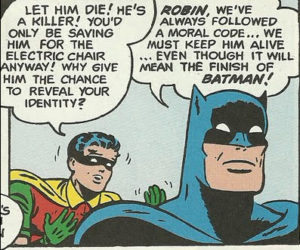
I’ve seen Batman comics, TV shows, video games and movies. In my favorite Batman stories (like Batman: The Animated Series) it almost goes without saying that Batman does not kill. Flimsier plot ideas—like the one I’m arbitrarily referencing with this picture, and “The Dark Knight” (2008)—pervert Batman’s No-Kill Code into a kind of substantive plot idea (like that Batman is somehow stupid or immoral for refusing to kill villains). [5]One day I’ll write more about Batman and add a link to that post here.
This Killing Taboo is Illusory
Even though everyone is supposed to know that killing is wrong, portrayals of the killing are pumped out by writers of narrative fiction daily. What’s going on?
Forensic psychologist Paul G. Mattiuzzi contends that a fascination with murder is nothing out of the ordinary, and in fact, is practically built-in to people. Said plainly: “The crime of murder is a most fundamental taboo and, also, perhaps, a most fundamental human impulse.”
Psychology Today, “Fascination With Murder—Should You Be Concerned About It?” 5/24/2018
Your Bored Brother is here to tell you that killing, for most people, is hardly a taboo at all.
Let me get two things out of the way:
- The technical distinction between “killing” and “murder,” while highly significant to criminal prosecutions, makes little emotional sense and the terms are used interchangeably in everyday life. Murder is a sub-type of killing, defined as “an illegal killing” or “wrongful killing.” So to say “murder is wrong” is a tautology, because the term murder itself is defined as a wrongful killing. People often use the word “murder” as a loaded term to refer to killings that they think are wrong (but are nevertheless lawful), e.g., “meat is murder,” “abortion is murder.” So I will deliberately use the terms “murder” and “killing” interchangeably.
- Although this series is really about “homicide,”[6]a word which almost literally means “man-killing” I think the distinction between killing human animals and non-human animals is not very clear, either emotionally or philosophically. I use the all-purpose word “killing” because it is an all-purpose concept. The way I see it, most people learn to kill from an early age because their elders teach them to kill non-human animals. From the nuisance animals that trespass into the home, to the farm animals served up on their plates, a young person quickly learns that their society expects them to kill (or to at least accept that others will kill). People learn to dominate animals to such an extent that they kill other animals solely for convenience or even just to pass the time. I think that learning to feel a certain way about killing non-human animals helps us feel the same way about killing human animals. After all, it is common knowledge that a warning sign for a potential serial killer is that the person tortures and/or kills non-human animals.[7]I often suspect that the logic of this remorseless domination of non-human animals, and the destruction of our natural empathy for them, are the kindergarten-arithmetic lessons upon which we build geometry courses in human-human subjugation. This idea is too gigantic to discuss in this post though.

DIsney’s old film “Bambi” (1942) is still the go-to reference for a movie that might make you feel bad about killing animals. There aren’t many.
With these points out of the way, let’s keep going.
The Acceptance of Killing Extends to Humans
I’ll gradually talk about the movies, but let’s talk about everyday life too. All sorts of stuff in society only makes sense if homicide[8]And I mean literally killing humans, not the criminal offense of homicide. is, on some level, acceptable:
1. We Know How to Do It
First of all, if killing each other were really so taboo, then why do we all learn how to do it?
I think that people do not have common knowledge about something that is really taboo. For example, I think human cannibalism is an actual taboo in American society. A key piece of evidence in support of this, in my opinion, is that you almost never meet someone who knows how to butcher and cook human flesh.[9]Well, I guess Hannibal Lecter continues to be a popular character, so maybe this will change.
By contrast, most people—even children—know some effective methods of killing another person. All they have to do is watch a few movies.
2. Guns
In the United States, everyday people possess weapons—guns—for the purpose of killing others if they deem it appropriate.[10]Steeped in gun culture, I learned from an early age that a firearm should never be aimed at a living thing without an intent to kill. Because I have never desired to personally kill anyone, even in self defense, or to personally kill anything bigger than a bug, I have not bothered to even touch a … Continue reading In other words, as an American, I can hardly walk 50 feet without getting into the presence of
- An object which solely exists for the purpose of killing people. My family members, people I work with, my neighbors, security officers, the police on patrol—these people all possess firearms and so I’m never far away from one.
- Someone who thinks killing other people is okay. Of course, they would probably qualify that by saying “in self defense” or whatever, but my point is that killing is obviously not a taboo if they’re ready to kill “in self defense” at every moment.[11]I also often meet other Americans who believe in vigilante justice. They secretly (or openly) praise such vigilante killers when they dispense this “justice.”
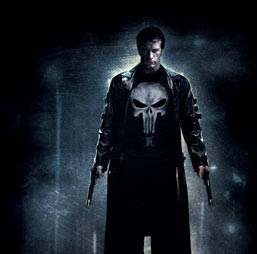
The Punisher, a comic-book hero featured in many movies and an ongoing TV series, doesn’t have any superpowers—just a lot of guns.
The heroes in many popular movies also possess guns, or else possess other powers or weapons that are just as deadly. In such movies, the hero’s capability and willingness to use guns (or other lethal force) is taken for granted. To put it another way, the revelation that the hero possesses deadly weapons or capabilities is rarely treated by the movie as something sinister in itself. I can’t a recall an American movie with a scene that portrays a hero’s possession of a firearm as a hint that the character might actually be evil or somehow not really a hero.[12]I’ve seen this in Japanese media, however.
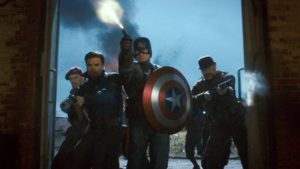
Captain America (a morally upright hero) is from the same Marvel comics as The Punisher (an anti-hero). The stories typically portray them as morally opposed, even literally fighting each other. Stories featuring the Punisher will emphasize how many guns he has, but other heroes—like Captain America—use firearms without comment.
3. Law Enforcement
In the United States and elsewhere, the justice system sometimes executes prisoners. Even if you think this is not justified, you must admit that the existence of capital punishment evidences that killing human beings is not taboo.
Even in U.S. states where the state government cannot lawfully execute prisoners, the government maintains police forces who possess deadly weapons and are authorized to use them when appropriate. The fact that American police possess guns necessarily assumes that the police can decide to kill citizens. And if the police can legally kill you (for whatever reason, like stopping you in the process of committing a horrible crime), then your society does not need a formal death penalty for some actions to be, in effect, punishable by death.[13]For the purposes of this writing, I am not taking a stance on state use of deadly force. I am simply trying to demonstrate that American society does accept some level of intentional killing of human beings. Despite this, I suspect that some readers will become upset or irritated that I describe … Continue reading
4. War
With my previous points in mind, I think it is fair to say that nearly all societies today, just from observing their armaments, assume that they will be killing each other at some point or another. The armed forces of the world possess all sorts of technologically-advanced weapons that have little purpose other than to kill people on an enormous scale (or related actions like threatening to kill them).
Furthermore, warriors who participate in wars that end the lives of millions will often return from war as heroes—especially in the United States.[14]I have to qualify this statement, because I think many Americans, especially war veterans, are not treated well at all. In particular, I think about injured and disabled veterans. It also occurs to me that veterans who aren’t white men are less likely to be accorded the respect or status of … Continue reading

This screen capture from “Transformers: Revenge of the Fallen” (2007) is indistinguishable from a U.S. military recruitment advertisement. You might say that about the whole series…
Soldiers exist to kill people. If we deem this inevitable or even desirable, we can can hardly describe killing as “taboo.”
At this point, I’m mostly just talking about society-wide boundaries—what about individuals? Some individuals’ personal, private reservations about killing are often far more lax than that of society in general. But we’ll get to that later on!
Movie Characters Kill, Even When They Don’t
Virtually every action-movie protagonist kills people left and right (or in a PG-13 movie, uses deadly force with an uncertain outcome). Protagonists in other movie genres kill as well. The hero is rarely upset and is never emotionally damaged by these experiences.[15]And if the hero is upset, the hero will learn the lesson that it is okay to kill and that the hero needs to get over it. The hero will then kill their enemies and feel better. The only time I can recall that not happening in a story like this is the Nickelodeon cartoon “Avatar: The Last … Continue reading Mowing down mooks, slaying the villain, none of it disturbs the hero.[16]Unless and until the story arbitrarily decides that a specific killing somehow matters, usually the “final boss” villain. This happens, for example, in “Wonder Woman” (2017) and “The Return of the Jedi” (1983). I don’t think it makes sense from a … Continue reading
The killing (or use of deadly force) is all incidental and not at all the topic or the point of the story. The prerogative and ability of the hero to kill other people is so accepted, so taken for granted, that these things don’t have to be explained, justified, or considered—not even slightly. In a PG movie, heroes probably won’t “kill” the villains, but will fight the villain in such a way that the villain accidentally dies anyways, so it hardly feels different since the audience’s lust for the villain’s blood is always satisfied.
For the purposes of this piece, I include “attempted killing” and “lethal force” in this very general understanding of killing. This is because many writers portray the characters (especially the heroes) using astounding levels of violence to overcome their enemies, but inform the audience that the victims of this violence did not actually die (or were barely hurt at all!). I am not going to give this kind of writing a pass. Characters who technically never kill someone (like Batman, or virtually every hero in action content aimed at a child audience) but nevertheless constantly dispense lethal-levels of violence onto their enemies are, in my opinion, not meaningfully different than killers.[17]As I pointed out, Batman famously has a “no-kill code.” However, Batman uses lethal force constantly and only by the writers’ fiat do his foes survive their encounters with Batman and nobody suffers any deadly collateral damage.
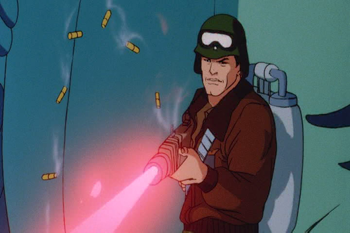
Observe this ridiculous screenshot from “G.I. Joe: A Real American Hero” (1983-1986). This apparent “laser gun” behaves in every way like a ballistic firearm (it even discharges spent shells). This image is absolutely representative of how gun violence was censored in 80’s/90’s American cartoons.
It is only by the divine miracle of the writers’ omnipotent power to portray anything (no matter how impossible or improbable) as literally happening in their stories that the victims of this violence survive. To me, this is no different than the 80s/90s-era cartoon television censorship technique of changing every kind of ballistic firearm into a non-deadly lasergun, even for stories with little-to-no science fiction premise.
They’re All Serial Killers
Applying the phrase “serial killer” in its loosest possible sense, almost every hero and villain in action/adventure stories is a serial killer. That is, these characters kill more than one person on different occasions.
But this is a silly observation, because everyone knows that a “serial killer” is a term of art applying to a person who kills others for some kind of perverse psychological gratification in the act of killing.
Right?
RIGHT?
Except… a lot of these characters, and the ways the audience is supposed to understand and relate to these characters, only make sense if there is some sort of perverse psychological gratification in the killing.
Many superheroes, for example, demonstrate a pathological hatred of criminals (Batman, The Punisher, Mr. Incredible, Rorschach). These heroes are immensely gratified by beating villains senseless or killing them outright. General action heroes, such as James Bond and his derivatives, take great pleasure in looking their foes directly in the eyes and insulting them before ending their lives.
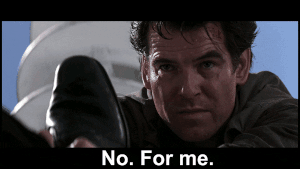
Agent 006 has just been subdued by Agent 007, James Bond. Agent 006 asks his former ally, “For England, James?” since that was the excuse Bond gave for leaving him to die on an earlier mission. “Goldeneye” (1995)
Many monstrous characters, such as vampires, need to kill people in order to sustain their own lives, but for every reluctant killer we get three more who revel in it.

The gleeful—even orgasmic—expressions of monster characters who consume people do not call to mind the feelings of a hunter who kills and consumes another animal for mere sustenance.
So what separates the technical “serial killers” that appear in popular stories from the kind of “serial killer” usually called to mind by the term? Not much!
If you’re intrigued, keep reading. If you think I’m full of it, keep reading! I’ve anticipated what you might think in response to these ideas, and I’ll tackle those responses in Part 5. Click here to read Part 5.
Footnotes
| ↑1 | The U.S. criminal justice system’s approach to crime and punishment is not exactly congruent to the beliefs of average Americans. The U.S. Supreme Court imposed this idea on the country through its power of interpreting the U.S. Constitution; long ago, there were plenty of Americans who apparently considered rape to potentially be as heinous a crime as murder (and probably all sorts of other offenses as well for that matter). Just because the U.S. criminal justice system treats murder as the most heinous offense, that doesn’t mean American society matches that view in their private thoughts. More on that later. |
|---|---|
| ↑2 | I think, theoretically, treason and drug-dealing might be punishable by death, but I don’t recall this ever happening without a connection to someone getting killed. |
| ↑3 | Sometimes in these exact terms. |
| ↑4 | Except in “Batman Begins” (2005) |
| ↑5 | One day I’ll write more about Batman and add a link to that post here. |
| ↑6 | a word which almost literally means “man-killing” |
| ↑7 | I often suspect that the logic of this remorseless domination of non-human animals, and the destruction of our natural empathy for them, are the kindergarten-arithmetic lessons upon which we build geometry courses in human-human subjugation. This idea is too gigantic to discuss in this post though. |
| ↑8 | And I mean literally killing humans, not the criminal offense of homicide. |
| ↑9 | Well, I guess Hannibal Lecter continues to be a popular character, so maybe this will change. |
| ↑10 | Steeped in gun culture, I learned from an early age that a firearm should never be aimed at a living thing without an intent to kill. Because I have never desired to personally kill anyone, even in self defense, or to personally kill anything bigger than a bug, I have not bothered to even touch a loaded gun. |
| ↑11 | I also often meet other Americans who believe in vigilante justice. They secretly (or openly) praise such vigilante killers when they dispense this “justice.” |
| ↑12 | I’ve seen this in Japanese media, however. |
| ↑13 | For the purposes of this writing, I am not taking a stance on state use of deadly force. I am simply trying to demonstrate that American society does accept some level of intentional killing of human beings. Despite this, I suspect that some readers will become upset or irritated that I describe state violence in clear, frank language, and will feel as though I am somehow condemning police and soldiers simply by describing what they do.
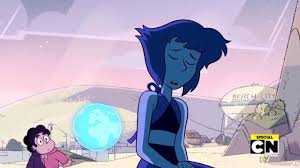 https://brotherbored.com/wp-content/uploads/2018/10/Lapis-Lazuli-cant-go-back-150x84.jpg 150w" sizes="auto, (max-width: 300px) 100vw, 300px" /> https://brotherbored.com/wp-content/uploads/2018/10/Lapis-Lazuli-cant-go-back-150x84.jpg 150w" sizes="auto, (max-width: 300px) 100vw, 300px" />“You kill people?” If this is your reaction, I encourage you to read one of my all-time favorite essays by George Orwell, “Politics and the English Language” (1946). |
| ↑14 | I have to qualify this statement, because I think many Americans, especially war veterans, are not treated well at all. In particular, I think about injured and disabled veterans. It also occurs to me that veterans who aren’t white men are less likely to be accorded the respect or status of other honorable veterans. But generally speaking, American culture heroizes war veterans. |
| ↑15 | And if the hero is upset, the hero will learn the lesson that it is okay to kill and that the hero needs to get over it. The hero will then kill their enemies and feel better. The only time I can recall that not happening in a story like this is the Nickelodeon cartoon “Avatar: The Last Airbender” (2005-2008), which of course is one of my favorite shows largely due to the moral complexity of the writing. |
| ↑16 | Unless and until the story arbitrarily decides that a specific killing somehow matters, usually the “final boss” villain. This happens, for example, in “Wonder Woman” (2017) and “The Return of the Jedi” (1983). I don’t think it makes sense from a storytelling point of view for the hero to kill enemy soldiers left and right and then suddenly hesitate to kill the person who is responsible for everything bad. In my opinion, that’s not a meaningful or realistic moral struggle. And more importantly for this essay, the hero hesitating to kill one specific person doesn’t negate their previously-established willingness to kill anonymous soldiers. |
| ↑17 | As I pointed out, Batman famously has a “no-kill code.” However, Batman uses lethal force constantly and only by the writers’ fiat do his foes survive their encounters with Batman and nobody suffers any deadly collateral damage. |